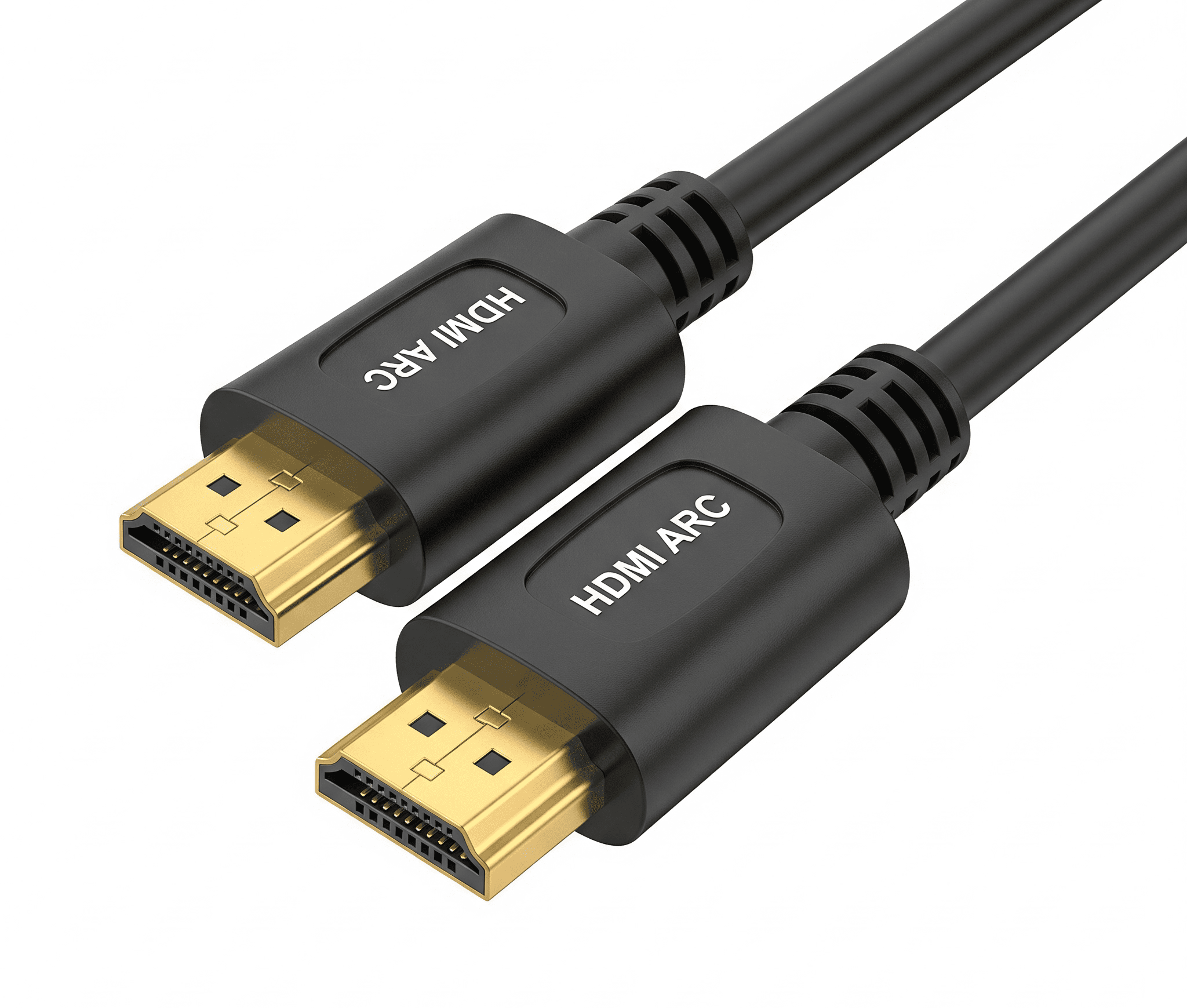Kingsgrove Branch:
HDMI ARC

HDMI ARC opens up a world of seamless audio-video experiences. Imagine a home theater where your TV and soundbar talk to each other without a hitch, effortlessly sharing audio and video signals. That's the magic of HDMI ARC. This technology acts like a super-connector, streamlining your entertainment setup and making it easier than ever to enjoy your favorite movies and shows with crystal-clear sound and picture quality
This guide dives deep into HDMI ARC, exploring its inner workings, benefits, potential drawbacks, and real-world applications. We'll compare it to other methods, highlight its advantages, and even troubleshoot common problems. Get ready to unlock the full potential of your home entertainment system!
Understanding HDMI ARC
HDMI ARC, or Audio Return Channel, is a feature in HDMI cable that lets you send audio signals back to a source device. It's a convenient way to get audio from your TV or other display to your sound system without needing extra cables. This simplifies your home theater setup and often saves you money
HDMI ARC Definition and Purpose
HDMI ARC is a specific feature of HDMI cables that allows audio signals to travel from a display device (like a TV) to an audio source device (like a soundbar or receiver) through a single HDMI cable. Its primary function is to simplify home theater setups by reducing the number of cables needed. It does this by returning the audio signal from the display to the source, which usually connects to the audio system
Key Technical Aspects of HDMI ARC
Technically, HDMI ARC leverages the existing HDMI infrastructure. It uses the same physical cable and protocol, but designates specific data streams for audio return. This means that the cable itself doesn't need any special modification, and your devices already likely support the protocol
Comparing HDMI ARC with Other Methods
| Feature | HDMI ARC | Optical Audio | Analog Audio |
| Cable Complexity | One HDMI cable for both audio and video | One optical cable for audio | Multiple analog cables for audio and video |
| Signal Quality | Generally high quality, depending on the devices | High quality if the equipment is good | Generally lower quality, susceptible to interference |
| Cost | Usually cheaper in the long run, as it reduces the number of cables | Moderate cost | Moderate to high cost, depending on the setup |
How HDMI ARC Works
The signal transmission process in HDMI ARC is quite straightforward. Audio data from the TV is sent back to the source device, usually a receiver or soundbar. The source device then processes this audio and plays it through its speakers. It works on a single cable, streamlining the setup and reducing cable clutter
- The TV sends the audio signal back to the source
- The source device decodes and plays the audio
- The process is controlled through the HDMI protocol
Benefits of Using HDMI ARC
Using HDMI ARC offers numerous advantages for a smooth home theater experience. It simplifies the setup and reduces the amount of cables required, often saving money in the long run. This also creates a more aesthetically pleasing and organized setup
- Simplified setup: Fewer cables needed
- Potential cost savings: Fewer cables and equipment to buy
- Seamless home theater experience: Easy audio and video configuration
HDMI ARC Limitations
HDMI ARC, like any technology, has limitations. Compatibility issues can arise with older or less-capable devices. Signal degradation, though rare, can occur over longer distances. It's important to consider these limitations when choosing your setup
- Compatibility issues with some older devices
- Potential signal degradation over longer cable runs
- Not always the best option for high-end audiophile setups
HDMI ARC Applications
HDMI ARC is widely used in modern home theater systems. It's an integral part of many modern TVs and soundbars, making it a popular choice for those seeking a streamlined setup
- Connecting TVs to soundbars or receivers
- Simplifying home entertainment systems
- Enabling seamless audio and video control
HDMI ARC and Audio Quality
HDMI ARC typically delivers good audio quality, comparable to optical audio in most cases. However, the quality depends on the devices used, their capabilities, and the audio formats being used
- Generally good quality for everyday use
- Quality can vary depending on the specific equipment
- May not be ideal for high-end audio applications
HDMI ARC and Schnap.com.au Products
Schnap.com.au likely carries a wide range of HDMI ARC-compatible products. Checking their website for a current list would be the best way to see what they offer
Troubleshooting HDMI ARC Issues
Common problems with HDMI ARC connections often involve incorrect settings or incompatible devices. Checking connections and settings is usually the first step
- Check connections for proper fit and integrity
- Verify settings on both the TV and source device
- Ensure devices are compatible
Future of HDMI ARC
The future of HDMI ARC likely involves further integration with other technologies and improved signal handling capabilities
- Potentially more advanced audio formats and quality
- Increased compatibility with new devices
- Continued improvement in signal transmission
Final Summary
In conclusion, HDMI ARC simplifies home theater setups, improving audio-video integration and potentially saving money. While it's not a perfect solution for every situation, its benefits often outweigh the limitations, especially for those looking for a streamlined and enjoyable home entertainment experience. Understanding its workings and potential drawbacks empowers you to make informed decisions about your home theater setup, see hdmi adapter
Ultimately, HDMI ARC is a powerful tool for enhancing your home entertainment experience, and this guide has hopefully illuminated its capabilities and limitations
Question & Answer Hub: Hdmi Arc
What is the difference between HDMI ARC and eARC?
eARC (Enhanced Audio Return Channel) builds upon HDMI ARC, offering support for higher-quality audio formats. ARC generally handles standard audio, while eARC expands this to encompass more advanced formats like Dolby Atmos and DTS:X. This means eARC provides a more comprehensive and immersive audio experience
Can I use HDMI ARC with different brands of devices?
Generally, yes, but compatibility can vary. It's always a good idea to check the specifications of your devices to ensure they support HDMI ARC before making a purchase
What happens if my audio and video are out of sync with HDMI ARC?
Audio-video sync issues with HDMI ARC can stem from various factors, including driver problems, faulty cables, or conflicting settings. Troubleshooting involves checking connections, updating drivers, and ensuring proper settings in your devices. If problems persist, consulting the device manuals or contacting support might be necessary
Does HDMI ARC work with all types of audio formats?
While HDMI ARC handles a broad range of audio formats, some lossy or compressed formats might not sound as crisp as uncompressed ones. This doesn't necessarily negate the quality but might not be ideal for critical listening
Recent posts

Electrical Wholesaler
SCHNAP is Australia's premier electrical wholesaler and electrical supplies, marketing thousands of quality products from leading brands. Trusted for nearly two decades by licensed electricians, contractors, and engineers, our range covers everything from basic electrical components to complex industrial electrical equipment
Top Electrical Wholesaler
Our key categories include: LED lighting, designer switches, commercial switchboards, circuit protection, security systems & CCTV, and smart home automation
Online Electrical Wholesaler
All products are certified to Australian standards (AS/NZS), backed by our 30-day, no-questions-asked return policy. Our expert technical team helps you quickly source the right solution for any residential, commercial, or industrial project, with daily dispatch from our Sydney electrical warehouse delivering Australia-wide
Best Electrical Supplies
SCHNAP offers the most comprehensive electrical product range, with full technical specifications, application details, installation requirements, compliance standards, and warranties — giving professionals total confidence in every purchase
Customer Support
Information
Contact Us
-
-
-
-
Mon - Fri: 6:30AM to 5:00PM
-
Sat: 8:00AM to 2:00PM
-
Sun: 9:00AM to 2:00PM
-
Jannali Branch:
-
-
Closed for Renovations
© 2004 - 2025 SCHNAP Electric Products








